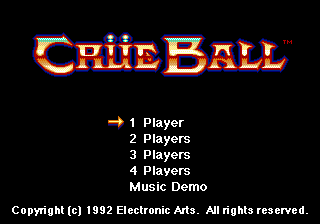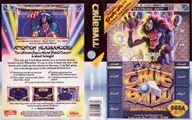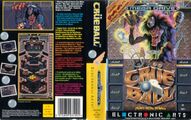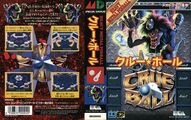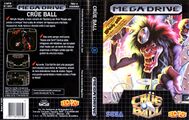Difference between revisions of "Crüe Ball"
From Sega Retro
m (Text replace - "| console=Mega Drive | region=US | front=" to "| console=Mega Drive | region=US | cover=") |
|||
| Line 31: | Line 31: | ||
| cvg=78 | | cvg=78 | ||
| cvg_source={{num|134}} | | cvg_source={{num|134}} | ||
| + | | joypad=79 | ||
| + | | joypad_source={{num|13}} | ||
}} | }} | ||
{{Scanbox | {{Scanbox | ||
Revision as of 07:48, 27 October 2012
This short article is in need of work. You can help Sega Retro by adding to it.
| Crüe Ball | |||||
|---|---|---|---|---|---|
| System(s): Sega Mega Drive | |||||
| Publisher: Electronic Arts (US/EU), Electronic Arts Victor (JP) | |||||
| Developer: NuFX | |||||
| Genre: Action | |||||
| Number of players: 1-4 | |||||
|
Crüe Ball (クルーボール) is a pinball video game developed and published by Electronic Arts for the Sega Mega Drive in 1992 in US and Europe and 1993 in Japan. The US and EU box labels the game Crüe Ball: Heavy Metal Pinball. The game was designed to sport a heavy metal look and feel and attained various endorsements before settling on a Mötley Crüe endorsement. Some of their music is used in the game while the level themes were composed by EA in-house composer Brian Schmidt.
Gameplay
![]() flips the left flipper,
flips the left flipper, ![]() flips the right flipper, and
flips the right flipper, and ![]() +
+![]() +
+![]() tilts. The goal of each table is to activate a ramp on the table which will shoot the ball to a bonus round and then to the next table. In the bonus rounds, the player is in control of a portable flipper: the D-pad moves around,
tilts. The goal of each table is to activate a ramp on the table which will shoot the ball to a bonus round and then to the next table. In the bonus rounds, the player is in control of a portable flipper: the D-pad moves around, ![]() ,
, ![]() , and
, and ![]() flip the flippers, and skeletons must be hit with three bonus balls.
flip the flippers, and skeletons must be hit with three bonus balls.
Physical Scans
| 67 | |
|---|---|
| Based on 36 reviews | |
- ↑ 1700 igr dlya Sega, "" (RU; 2001-xx-xx), page 52
- ↑ Aktueller Software Markt, "Dezember 1992" (DE; 1992-11-13), page 150
- ↑ Beep! MegaDrive, "January 1993" (JP; 1992-12-08), page 31
- ↑ Computer & Video Games, "January 1993" (UK; 1992-12-15), page 38
- ↑ Computer + Video Giochi, "Gennaio 1993" (IT; 199x-xx-xx), page 113
- ↑ Digitiser (UK) (1993-01-02)
- ↑ Electronic Gaming Monthly, "December 1992" (US; 1992-xx-xx), page 32
- ↑ Entsiklopediya luchshikh igr Sega. Vypusk 1, "" (RU; 1999-xx-xx), page 302
- ↑ Mean Machines: The Essential Sega Guide, "" (UK; 1993-11-18), page 34
- ↑ Famitsu, "1993-01-01" (JP; 1992-12-18), page 44
- ↑ GameFan, "Volume 1, Issue 3: January 1993" (US; 199x-xx-xx), page 10
- ↑ Game Power, "Gennaio 1993" (IT; 199x-xx-xx), page 78
- ↑ GamePro, "March 1993" (US; 1993-xx-xx), page 130
- ↑ Game Zone, "October 1992" (UK; 1992-09-24), page 70
- ↑ Hippon Super, "January 1993" (JP; 1992-12-04), page 83
- ↑ Hobby Consolas, "Enero 1993" (ES; 199x-xx-xx), page 114
- ↑ Joypad, "Octobre 1992" (FR; 1992-10-xx), page 60
- ↑ Joystick, "Octobre 1992" (FR; 1992-xx-xx), page 147
- ↑ Sega Mega Drive Advanced Gaming, "January 1993" (UK; 199x-xx-xx), page 91
- ↑ Mega Drive Fan, "March 1993" (JP; 1993-02-xx), page 59
- ↑ Mega Force, "Octobre 1992" (FR; 1992-xx-xx), page 82
- ↑ MegaTech, "September 1992" (UK; 1992-08-20), page 34
- ↑ Micromanía (segunda época), "Enero 1993" (ES; 199x-xx-xx), page 56
- ↑ Mean Machines, "September 1992" (UK; 1992-08-27), page 100
- ↑ Marukatsu Mega Drive, "January 1993" (JP; 1992-12-xx), page 109
- ↑ Mean Machines Sega, "October 1992" (UK; 1992-09-xx), page 142
- ↑ Player One, "Décembre 1992" (FR; 1992-12-10), page 94
- ↑ Play Time, "1/93" (DE; 1992-12-09), page 94
- ↑ Sega Power, "October 1992" (UK; 1992-09-03), page 26
- ↑ Sega Pro, "Christmas 1992" (UK; 1992-12-10), page 36
- ↑ Sega Pro, "April 1993" (UK; 1993-03-11), page 64
- ↑ Sega Force, "3/93" (SE; 1993-05-13), page 12
- ↑ Sega Force, "December 1992" (UK; 1992-11-05), page 68
- ↑ Sega Saturn Magazine, "September 1995" (JP; 1995-08-08), page 87
- ↑ Tricks 16 bit, "Tricks Sega Gold 800 igr" (RU; 1998-03-20), page 46
- ↑ Video Games, "11/92" (DE; 1992-10-28), page 50
